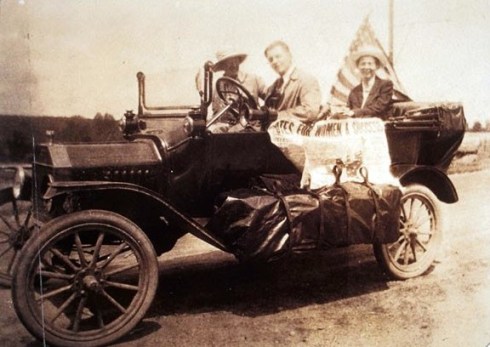Today’s post is a perfect example of how my mind works and why looming deadlines force me out of my home office and into my university one, or to the library, or anywhere but home. I was very quietly reading a great book about English migration in the seventeenth century, in preparation for my upcoming graduate class, when my mind started to wander to maps: first to maps of the Atlantic world, then to maps of the early modern world, then to nineteenth-century imperial maps, then to allegorical maps, then to propaganda maps, then to maps which had spider motifs. This wandering started with the title of the book, The Web of Empire, but it was definitely prolonged by my materialistic instincts, as I have finally ejected my husband’s saltwater aquarium from the lovely little room that I used to call my “map room”, and will again. This room was very damaged by leaks from ice dams this past winter, and has been recently been re-papered and -plastered, so I’m in redecoration mode. I had several old maps and globes in there, but even before our fierce February they were threatened by the vapors emanating from that old aquarium, so now that it is out of there the maps are going back in–and I want more. I’m a huge fan of allegorical and pictorial maps (see here and here and here), so I thought, why not spiders? They’re not quite as obvious a metaphor for world domination as the octopus, but a close second.
I started my search for arachnophobic maps with the early nineteenth century and Napoleon: Thomas Rowlandson had very famously portrayed the little general as “the Corsican Spider” and I figured some contemporary cartographer would be inspired to create a vision of Europe caught in his web. No luck, and nothing from the Victorians either, although one of Lillian Lancaster Tennant’s whimsical maps depicts the old legend of Robert the Bruce and his inspiring spider. This is hardly the arachnophobia I was expecting, or looking for: it will take the ferocious World War I–and the polarizing imperial strategies of the rest of the twentieth century–to produce those kind of images.
Thomas Rowlandson’s The Corsican Spider. In his Web. (1808), Royal Collection Trust; Bonaparte with a spider web as a medal, having devoured Russia (1814), Jonathan Potter, Ltd.; Map of Scotland from Stories of Old (1912) by Lillian Lancaster Tennant, Barron Maps.
And so that brings us to probably the most famous spider map: “L’Entente Cordiale, 1915”. This propaganda map represents the German perspective on World War I, with Britain portrayed as a giant spider literally eating France while the US is entangled in its web in the background and an unfettered German eagle overlooks the scene. This is a mockery of the alliance made between France and Britain in the previous year, which clearly did not aid/save France. I found several other British spiders in various collections of German propaganda from the Great War, including the map below from (of all places) neutral Sweden, and the “Europa 1915-1916” map which depicts the insect extending its legs across the Channel while Germany is (quite literally) steamrolling the Russian bear: this view conforms to the German rationalization that it was Britain that had woven a web of empire, spanning the globe.
l’Entente Cordiale, 1915, Library of Congress; England Världens lyckliggörare, 1918, War Reserve Collection, Cambridge University Library. (I’m not entirely certain that this Swedish poster is not depicting an English octopus: there is no web, but it does look quite furry); Europa 1915-1916, Imperial War Museum.
The spider allegory is unleashed in the 1930s and 1940s: Nazi Germany produced many anti-Semitic and anti-Communist pamphlets and posters (and combinations thereof) employing the spider, and then we see all the participants portraying the enemy in arachnidian ways once the war began. The U.S.S.R. is portrayed as a menacing spider by both the Germans and the Americans in the space of five years, and then of course Hitler/Germany becomes the most menacing spider of all. I’m including a well-shared image of “The American Spider” which is dated 1943 because it’s a perfect fit for this post, but I’m not sure of the source: tumblr-and reddit-land never credits! I’ve searched all the usual repositories and come up with nothing, but I would love to know about more about this particular spider map.
Germany struggles to keep Europe free from Bolshevism, 1935, Hoover Institute, Stanford University; The Russian Spider Sits atop the World and Watches for more Victims, Los Angeles Times, January 7, 1940 (during the brief German-Russian alliance), Barry Ruderman Antique Maps, Inc.; One by One his Legs will be Broken, 1941, Imperial War Museum; The American Spider, 1943, source–Vichy France?
The spider need not be so malevolent. Another map from this era, published by Ernest Dudley Chase, one of the most prolific and creative pictorial cartographers of the mid-twentieth century based right here in Massachusetts, features a spider web as a sort of overcast underworld. Following in the wake of “A New Yorker’s Idea of the United States of America” and “A Bostonian’s Idea of the United States of America”, Chase’s “The United States as viewed by California (Very Unofficial) Distorted and Drawn by Ernest Dudley Chase”, contrasts a distorted two-thirds of interwoven America with a very sunny, happy California. I’ve included a quote from another of Chase’s maps for parity’s sake. And because our own twenty-first century view of the web is quite different from that of the previous century, I’m ending with this great “Age of Internet Empires” map from the Oxford Internet Institute. I could go on–rail transportation maps are often called “spider maps”–but I think I’ve been entangled enough!
Ernest Dudley Chase maps, Boston Public Library Leventhal Map Center; “Age of Internet Empires Map”, Oxford Internet Institute.




































































































